Research on the Early Warning Model for Pipelines Due to Landslide Geohazards under Multiple Influencing Factors
Abstract
:1. Introduction
2. Site Survey
3. Numerical Simulation
3.1. Simulation of Working Conditions
3.2. Simulation Parameters
3.3. Simulation Results
3.3.1. The Pipeline Crossing Landslide Laterally
3.3.2. The Pipeline Crossing Landslide Longitudinally
3.4. Discussion of Simulation Results
- Whether the pipe crosses the landslide laterally or longitudinally, the effects of landslide slope, landslide thickness, and landslide length on pipeline deformation are consistent with the same trend, which means that the degree of pipeline deformation is increasing with those variables. It is because both the mass of the unstable soil above the pipe and the unbalance force become larger as these quantities become larger. Thus, the deformation of the pipeline becomes larger.
- When the pipeline crosses the landslide laterally, it is noticed that the pipeline deformation decreases with the increasing width of the landslide body. The smaller the landslide width is, the more concentrated the strain is, and, therefore, the larger the pipeline deformation is.
- When the pipeline crosses the landslide laterally, the pipelines are relatively safe at the leading edge of the landslide body, followed by the trailing edge of the landslide body, and are most dangerous in the middle of the landslide body. The unbalanced force is the slightest because the soil at the front edge of the landslide body is supported by the stable soil below. Thus, the deformation of pipelines is minor when the pipeline is located at the front edge of the landslide body. Furthermore, the unstable soil mass carried in the middle of the landslide body is more significant than that at the back edge of the landslide body. Therefore, the pipeline in the middle of the landslide body shows the most significant deformation.
4. Quantitative Impact of Influencing Factors and Early Warning Models
4.1. Quantitative Impact of Influencing Factors
4.2. Discussion of the Early Warning Models
5. Conclusions
- Through a field investigation, we found that the scale of landslides, including the length, width, slope, and thickness, and the relative position of the pipeline landslide are the main factors determining the deformation of pipelines induced by landslides. The degree of the pipeline’s deformation was determined by the relative position between the pipeline’s location and the landslide and the landslide scale.
- Based on numerical simulation, no matter whether the pipeline crosses the landslide laterally or longitudinally, with the increase of the landslides’ angles, thicknesses, and lengths, the deformation characteristic of pipelines appears almost identical. The deformation of pipelines keeps continues to increase. The smaller the landslide width is, the more concentrated the strain is, and therefore, the larger the pipeline deformation is.
- When the pipelines cross the landslides laterally, the deformation of pipelines reduces with the broadening of the width of landslides, it is safer for the pipelines buried in the leading edge of landslides than the tail edge, and it is most dangerous when the pipelines are located in the middle of landslides.
- Considering the variation of the scale, a piecewise forewarning model including multiple parameters was established based on the influence function for crossing pipelines in landslides.
Author Contributions
Funding
Data Availability Statement
Acknowledgments
Conflicts of Interest
Abbreviations
| InSAR | Interferometric synthetic aperture radar |
| FBG | Fiber Bragg grating |
| SSAW | Steel pipe of spiral seam submerged arc welded |
| ILDTs | In-line device technologies |
| TTBTs | Transient test-based techniques |
| ρ | Density |
| E | Elastic modulus |
| φ | Internal friction |
| C | Cohesive force |
| D | Outside diameter of the pipeline |
| T | Thickness of pipeline |
| μ | Poisson’s ratio |
| σS | Minimum yield strength |
| d | Deformation of pipeline |
| xn | Influence factor |
| f(xn) | Influence function |
| K | Benchmark data |
| A | Slope of the landslide body |
| w | Width of the landslide body |
References
- Bekaert, D.P.S.; Handwerger, A.L.; Agram, P.; Kirschbaum, D.B. InSAR-Based Detection Method for Mapping and Monitoring Slow-Moving Landslides in Remote Regions with Steep and Mountainous Terrain: An Application to Nepal. Remote Sens. Environ. 2020, 249, 111983. [Google Scholar] [CrossRef]
- Ding, C.; Feng, G.; Liao, M.; Tao, P.; Zhang, L.; Xu, Q. Displacement History and Potential Triggering Factors of Baige Landslides, China Revealed by Optical Imagery Time Series. Remote Sens. Environ. 2021, 254, 112253. [Google Scholar] [CrossRef]
- Liu, Z.; Qiu, H.; Ma, S.; Yang, D.; Pei, Y.; Du, C.; Sun, H.; Hu, S.; Zhu, Y. Surface Displacement and Topographic Change Analysis of the Changhe Landslide on September 14, 2019, China. Landslides 2021, 18, 1471–1483. [Google Scholar] [CrossRef]
- Pei, Y.; Qiu, H.; Yang, D.; Liu, Z.; Ma, S.; Li, J.; Cao, M.; Wufuer, W. Increasing Landslide Activity in the Taxkorgan River Basin (Eastern Pamirs Plateau, China) Driven by Climate Change. CATENA 2023, 223, 106911. [Google Scholar] [CrossRef]
- Liu, Z.; Qiu, H.; Zhu, Y.; Liu, Y.; Yang, D.; Ma, S.; Zhang, J.; Wang, Y.; Wang, L.; Tang, B. Efficient Identification and Monitoring of Landslides by Time-Series InSAR Combining Single-and Multi-Look Phases. Remote Sens. 2022, 14, 1026. [Google Scholar] [CrossRef]
- Wang, L.; Qiu, H.; Zhou, W.; Zhu, Y.; Liu, Z.; Ma, S.; Yang, D.; Tang, B. The Post-Failure Spatiotemporal Deformation of Certain Translational Landslides May Follow the Pre-Failure Pattern. Remote Sens. 2022, 14, 2333. [Google Scholar] [CrossRef]
- Zhou, W.; Qiu, H.; Wang, L.; Pei, Y.; Tang, B.; Ma, S.; Yang, D.; Cao, M. Combining Rainfall-Induced Shallow Landslides and Subsequent Debris Flows for Hazard Chain Prediction. Catena 2022, 213, 106199. [Google Scholar] [CrossRef]
- Yin, Y.; Zheng, W.; Liu, Y.; Zhang, J.; Li, X. Integration of GPS with InSAR to Monitoring of the Jiaju Landslide in Sichuan, China. Landslides 2010, 7, 359–365. [Google Scholar] [CrossRef]
- Meniconi, S.; Capponi, C.; Frisinghelli, M.; Brunone, B. Leak Detection in a Real Transmission Main through Transient Tests: Deeds and Misdeeds. Water Resour. Res. 2021, 57, e2020WR027838. [Google Scholar] [CrossRef]
- Meniconi, S.; Cifrodelli, M.; Capponi, C.; Duan, H.-F.; Brunone, B. Transient Response Analysis of Branched Pipe Systems toward a Reliable Skeletonization. J. Water Resour. Plan. Manag. 2021, 147, 04020109. [Google Scholar] [CrossRef]
- Shuai, J.; Wang, X.L.; Zuo, S.Z. Breakage Action and Defend Measures to Pipeline under Geological Disaster. Welded Pipe Tube 2008, 31, 9–15. [Google Scholar]
- Zahid, U.; Godio, A.; Mauro, S. An Analytical Procedure for Modelling Pipeline-Landslide Interaction in Gas Pipelines. J. Nat. Gas Sci. Eng. 2020, 81, 103474. [Google Scholar] [CrossRef]
- Tsatsis, A.; Gazetas, G.; Kourkoulis, R. Pipeline Response under Landslide Action. Geohazards Pipelines 2021, 107–121. [Google Scholar] [CrossRef]
- Deng, D.M.; Zhou, X.H.; Shen, Y.P. Calculation of Pipeline Inner Force and Distortion during Transverse Landslide Body. Oil Gas Storage Transp. 1998, 17, 18–22. [Google Scholar]
- Pei, H.; Cui, P.; Yin, J.; Zhu, H.; Chen, X.; Pei, L.; Xu, D. Monitoring and Warning of Landslides and Debris Flows Using an Optical Fiber Sensor Technology. J. Mt. Sci. 2011, 8, 728–738. [Google Scholar] [CrossRef]
- Rajani, B.B.; Robertson, P.K.; Morgenstern, N.R. Simplified Design Methods for Pipelines Subject to Transverse and Longitudinal Soil Movements. Can. Geotech. J. 1995, 32, 309–323. [Google Scholar] [CrossRef]
- Sarvanis, G.C.; Karamanos, S.A. Analytical Model for the Strain Analysis of Continuous Buried Pipelines in Geohazard Areas. Eng. Struct. 2017, 152, 57–69. [Google Scholar] [CrossRef]
- Chan, P.D.S. Soil-Pipe Interaction in Slopes. Master’s Thesis, University of Calgary, Calgary, AB, Canada, 1999. [Google Scholar] [CrossRef]
- Challamel, N.; de Buhan, P. Mixed Modelling Applied to Soil-Pipe Interaction. Comput. Geotech. 2003, 30, 205–216. [Google Scholar] [CrossRef]
- Zhang, D.C.; Bykov, L.I. The Force-Summing Analysis of Buried Pipeline under Landslide Condition. Pet. Plan. Eng. 2001, 12, 1–3. [Google Scholar]
- Bruschi, R.; Spinazze, M.; Tomassini, D.; Cuscuna, S.; Venzi, S. Failure Modes for Pipelines in Landslide Areas; American Society of Mechanical Engineers: New York, NY, USA, 1995. [Google Scholar]
- Bruschi, R.; Glavina, S.; Spinazze, M.; Tomassini, D.; Bonanni, S.; Cuscuna, S. Pipelines Subject to Slow Landslide Movements: Structural Modeling vs. Field Measurement; American Society of Mechanical Engineers: New York, NY, USA, 1996. [Google Scholar]
- Zhang, Y.; Wang, Z.; Yang, Q.; Wang, H. Numerical Analysis of the Impact Forces Exerted by Submarine Landslides on Pipelines. Appl. Ocean Res. 2019, 92, 101936. [Google Scholar] [CrossRef]
- Zheng, J.Y.; Zhang, B.J.; Liu, P.F.; Wu, L.L. Failure Analysis and Safety Evaluation of Buried Pipeline Due to Deflection of Landslide Process. Eng. Fail. Anal. 2012, 25, 156–168. [Google Scholar] [CrossRef]
- Yan, Y.; Yang, D.S.; Geng, D.X.; Hu, S.; Wang, Z.A.; Hu, W.; Yin, S.Y. Disaster Reduction Stick Equipment: A Method for Monitoring and Early Warning of Pipeline-Landslide Hazards. J. Mt. Sci. 2019, 16, 2687–2700. [Google Scholar] [CrossRef]
- Umbrello, D.; M’Saoubi, R.; Outeiro, J.C. The Influence of Johnson-Cook Material Constants on Finite Element Simulation of Machining of AISI 316L Steel. Int. J. Mach. Tools Manuf. 2007, 47, 462–470. [Google Scholar] [CrossRef]
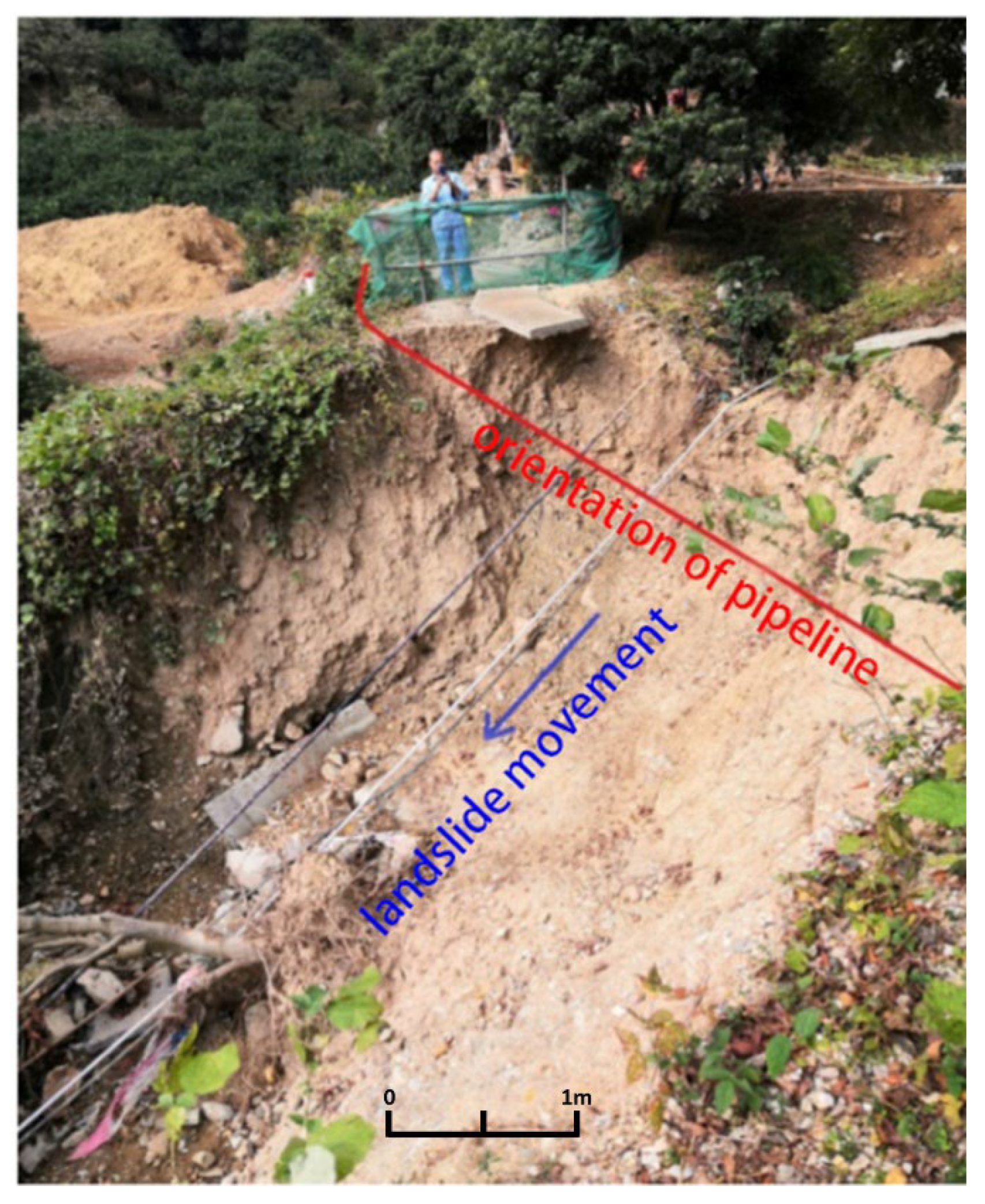

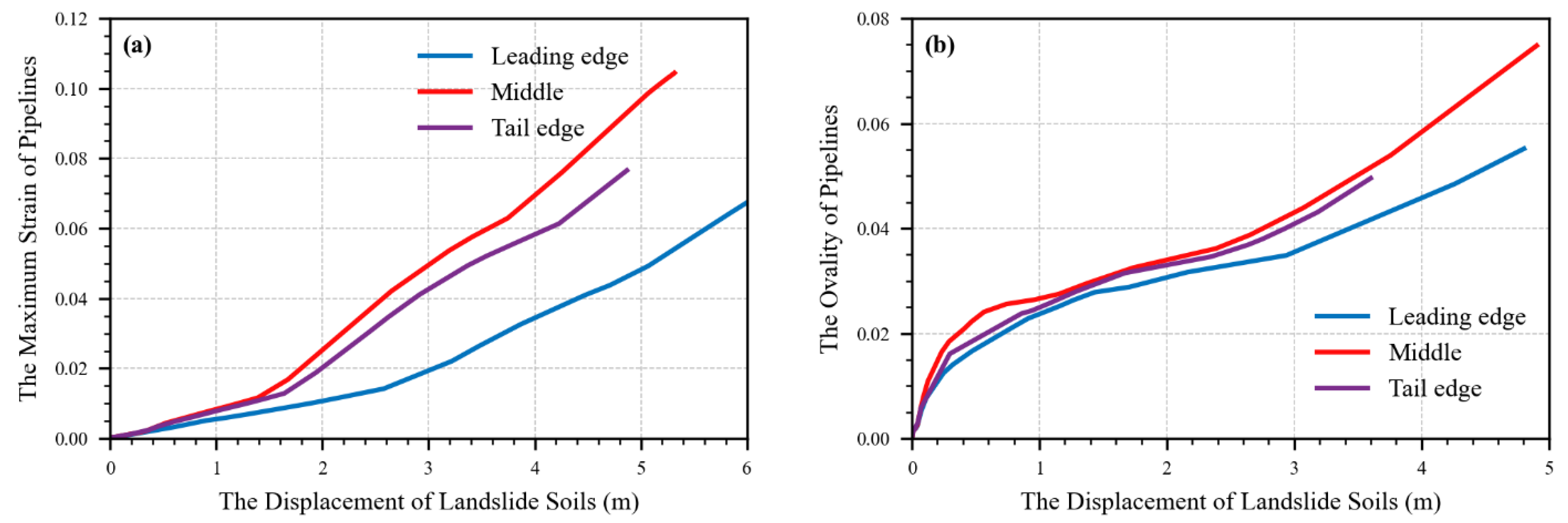
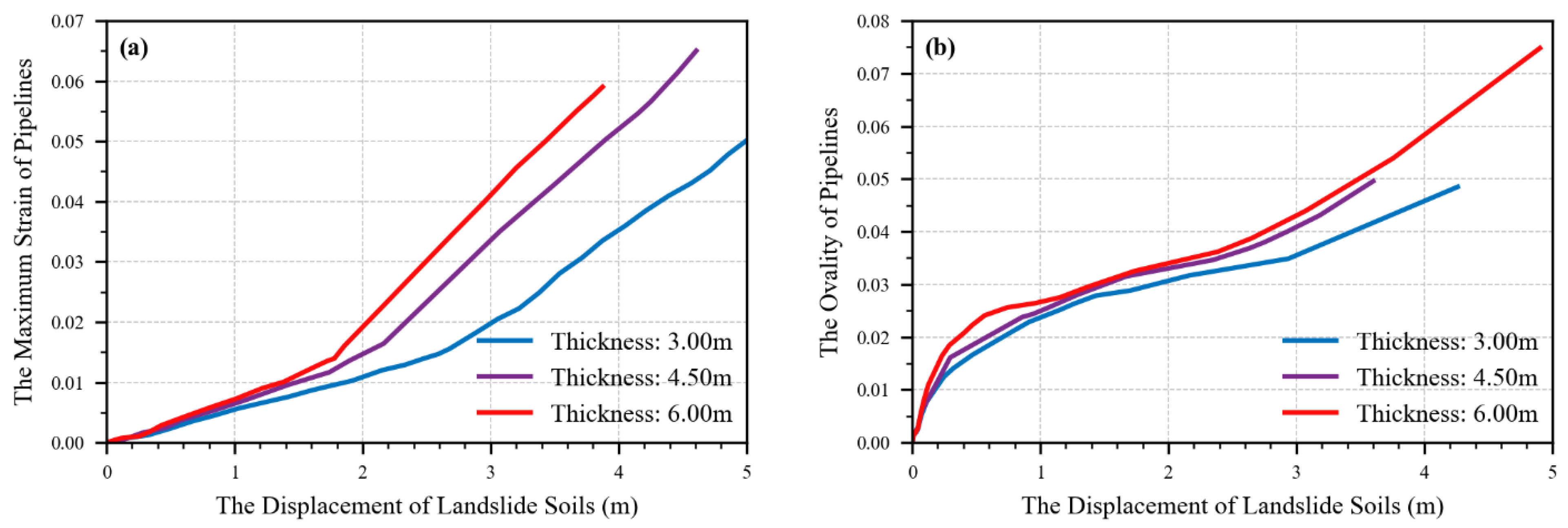


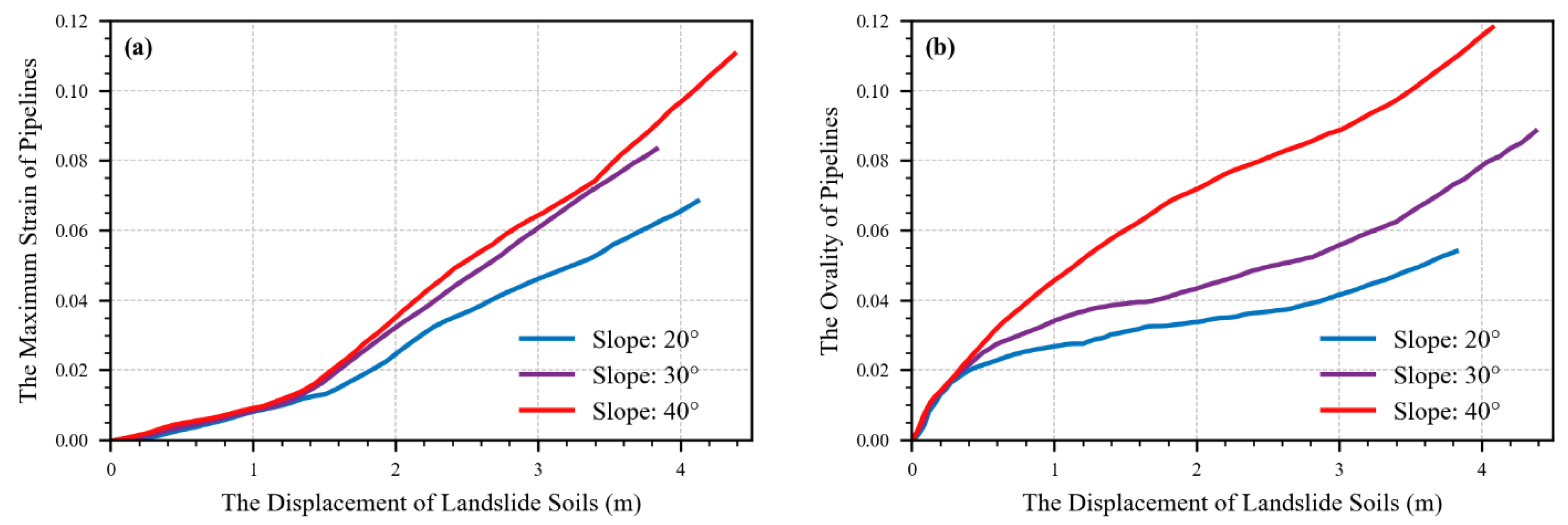
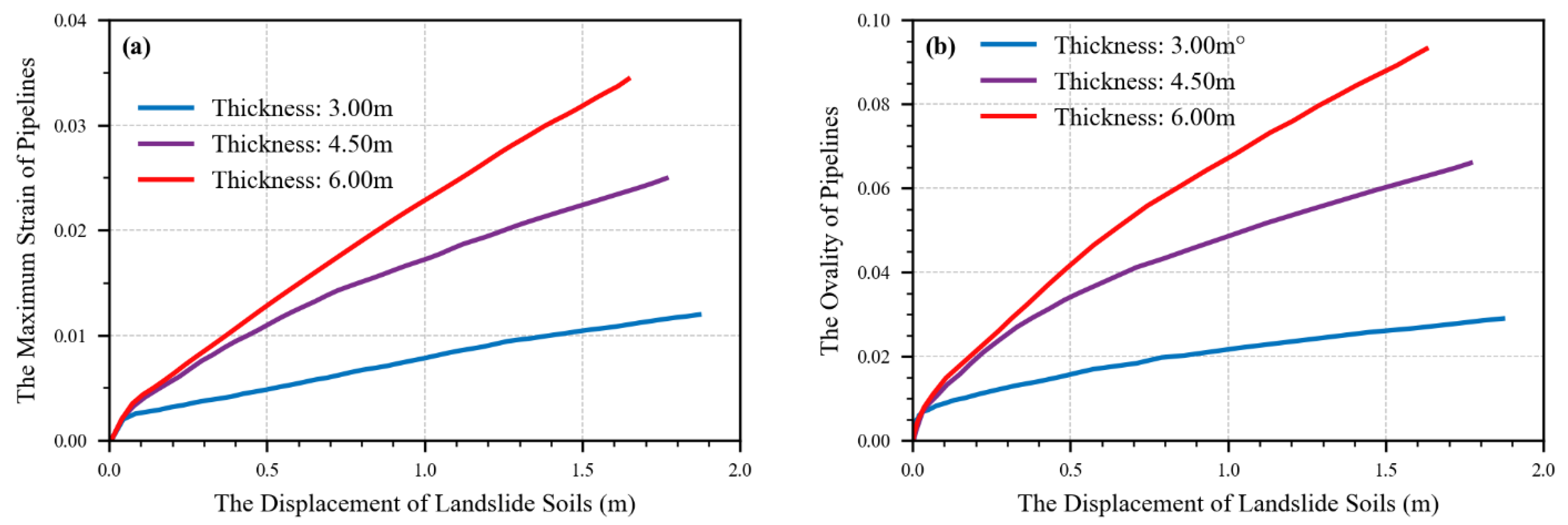

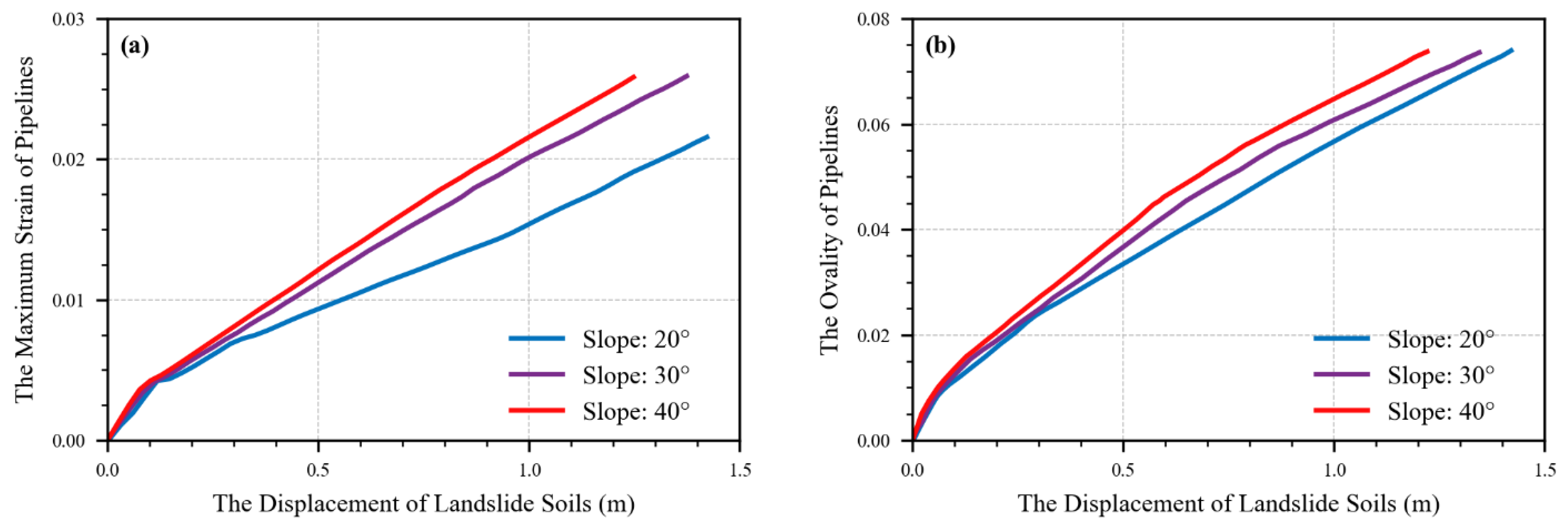

| Category | Value | |
|---|---|---|
| landslide | width (m) | 30/40/50 |
| thickness (m) | 3/4.5/6 | |
| slope (°) | 20/30/40 | |
| length (m) | 30/60/90 | |
| relative location of the pipeline | pipeline crossing landslide laterally | leading edge/middle/tail edge |
| pipeline crossing landslide longitudinally | middle | |
| Materials | State | Density ρ (kg/m³) | Elastic Modulus E (MPa) | Poisson’s Coefficient μ | Internal Friction φ (°) | Cohesive Force C (kPa) |
|---|---|---|---|---|---|---|
| Landslide body | saturated | 2360 | 20 | 0.35 | 15.0 | 13.0 |
| Support area | natural | 1980 | 20 | 0.3 | 18.0 | 25.0 |
| Basement of slope | / | 2600 | 5.56 × 104 | 0.23 | 35.0 | 26.0 |
| Item | Value | Item | Value |
|---|---|---|---|
| Steel types | L320 | Outside diameter D (mm) | 610 |
| Elastic modulus E (MPa) | 2.1 × 105 | Thickness T (mm) | 7.9 |
| Poisson’s ratio μ | 0.25 | Minimum yield strength σS (MPa) | 320 |
| Density ρ (kg/m3) | 7800 |
| Category | Function |
|---|---|
| Relative location | Not considering other influence factors, the deformation degree of the pipeline in the middle of the landslide is 1.6 times at the leading edge of the landslide, and the deformation degree of a pipeline at the tail edge is 1.4 times at the leading edge |
| Slopes of landslide | |
| Thickness of landslide | |
| Lengths of landslide | |
| Global influence function |
| Category | Function |
|---|---|
| Slopes of landslide | |
| Thickness of landslide | |
| Lengths of landslide | |
| Global influence function |
Disclaimer/Publisher’s Note: The statements, opinions and data contained in all publications are solely those of the individual author(s) and contributor(s) and not of MDPI and/or the editor(s). MDPI and/or the editor(s) disclaim responsibility for any injury to people or property resulting from any ideas, methods, instructions or products referred to in the content. |
© 2023 by the authors. Licensee MDPI, Basel, Switzerland. This article is an open access article distributed under the terms and conditions of the Creative Commons Attribution (CC BY) license (https://creativecommons.org/licenses/by/4.0/).
Share and Cite
Ning, P.; Jiang, Y.-j.; Tang, J.-j.; Xie, Q.-j. Research on the Early Warning Model for Pipelines Due to Landslide Geohazards under Multiple Influencing Factors. Water 2023, 15, 693. https://doi.org/10.3390/w15040693
Ning P, Jiang Y-j, Tang J-j, Xie Q-j. Research on the Early Warning Model for Pipelines Due to Landslide Geohazards under Multiple Influencing Factors. Water. 2023; 15(4):693. https://doi.org/10.3390/w15040693
Chicago/Turabian StyleNing, Po, Yuan-jun Jiang, Jun-jie Tang, and Qi-jun Xie. 2023. "Research on the Early Warning Model for Pipelines Due to Landslide Geohazards under Multiple Influencing Factors" Water 15, no. 4: 693. https://doi.org/10.3390/w15040693
APA StyleNing, P., Jiang, Y.-j., Tang, J.-j., & Xie, Q.-j. (2023). Research on the Early Warning Model for Pipelines Due to Landslide Geohazards under Multiple Influencing Factors. Water, 15(4), 693. https://doi.org/10.3390/w15040693





